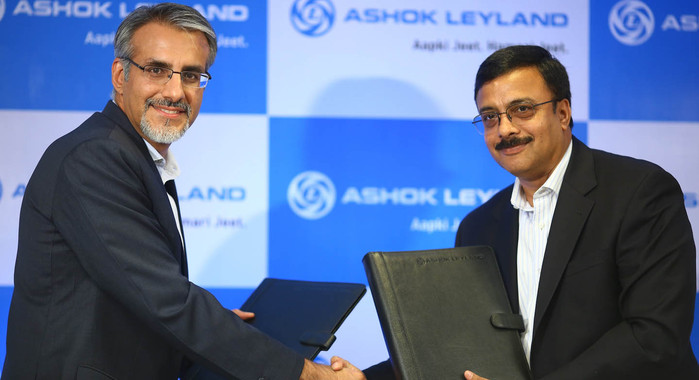By Sumantra Barooah
A full electric city bus today costs around Rs. 1.5 crore. The first electric city bus by Ashok Leyland, expected to be launched by late next year, would be significantly cheaper, perhaps by over Rs 30 lakh. That would be not because of any heavy discount but thanks to a new alliance which takes out the battery (the most expensive and very heavy component of an EV) and its charging from the cost equation.
Ashok Leyland has made a head-start in electric and hybrid buses, in both CNG and diesel, including those that do not require a plug-in. Sun Mobility aims to be a leading provider of universal energy infrastructure and services to accelerate mass EV usage.
Sun Mobility plans to revolutionise the transportation sector by deploying a unique open-architecture ecosystem built around its proprietory smart batteries and a network of quick interchange battery stations.
These stations, mainly powered by renewable energy, will refuel EVs at a cost lower than and faster than conventional petrol-diesel fuel stations. “Our focus is commercial viability (of EVs) today,” Chetan Maini, vice-chairman, Sun Mobility, told Autocar Professional. Of the various methods of ‘refuelling’ an EV – overnight charging, one-hour fast charging, ultra-fast charging in less than an hour and swapping, the swapping style helps remove the battery from the equation, lowers the cost and removes range anxiety the fastest. Maini is betting on this advantage for electric mobility in India to gain from, and of course, for Sun Mobility to succeed.
Commenting on the alliance, Vinod K Dasari, CEO and MD, Ashok Leyland, says, “Ashok Leyland has always leveraged Indian engineering and innovation to develop world-class solutions. We were the first and only manufacturer to develop BS III emission compliance using a mechanical fuel pump.
We were also the first in India to develop an SCR-based BS IV solution in 2010. In 2017, we were the world’s first and only company to develop an EGR-based BS IV solution, called iEGR. Our partnership with Sun Mobility is yet another step towards bringing world-class solutions to India, developed in India, and by Indians. We hope to bring several new innovative products to the market at the earliest.”
It was in 2010 that India first got the National Electric Mobility Mission Plan. With that as the base, the FAME India Scheme was launched in April 2015 to promote electric and hybrid vehicles in India. The roadmap for future mobility solutions, released in May by Central government think-tank NITI Ayog, has also focused heavily on electric mobility. Industry leaders say that unlike earlier occasions, the government is more focused and determined to make mass electric mobility a reality. For that to happen, all stakeholders will have to invest significantly. “This would need a level of partnership that the industry hasn’t seen before,” says Maini.
NEW SMART SOLUTION
Sun Mobility, a 50:50 joint venture between Virya Mobility 5.0 and Sun New Energy Systems, pioneers in areas of electric mobility and clean energy, says it will partner with multiple OEMs to integrate its proprietary smart battery solution into a range of innovative EVs – cars, buses, rickshaws and scooters.

The smart batteries will be modular, easily swappable, highly secure, IoT-enabled and can be easily refuelled on a pay-as-you go basis. This energy infrastructure integrated with EVs, smart batteries and clean energy will accelerate the transformation of mobility towards a sustainable, pollution-free future.
Commercial vehicles – city buses, cars owned by cab aggregators and three-wheelers – will be largely targeted to promote electric mobility in the country. Two-wheelers, the biggest segment in the EV industry currently, is also poised to see growth in the coming years.
In an EV, the battery is the most expensive, and also the heaviest component. In the case of buses, Sun Mobility will fit swappable batteries, which are only 20-25 percent of the size of a conventional EV bus battery. “It’s a very flexible open solution where there’s no difference in the price of a bus, whether you are doing 150 or 250 kilometres a day,” says Maini. With smaller batteries, both the operating cost and the overall weight of the vehicle are reduced.
In terms of cost, an electric bus, with the battery and charging system out of the equation, is costlier than a conventional bus with a regular diesel powertrain, but Maini says it will be more cost effective than a conventional bus with a more powerful powertrain and automatic transmission.
A “few patents on the overall ecosystem” of Sun Mobility’s business model, which also includes the battery swapping and management and some core battery technology. Since India doesn’t have any cell manufacturer, the company imports the cells and builds the rest indigenously. In the future, as business grows, Sun Mobility “may probably be directly or strategically involved” in the business of cell manufacturing.
Sun Mobility is in “advanced discussions” with some OEMs and mobility services providers for alliances like the one it has struck with Ashok Leyland. Maini wants to provide different solutions for different players. “Across the chain there will be different types of partnership with companies,” he says.

A strong focus by the government on making mass electric mobility a reality, also presents a good opportunity for standardisation of some systems and processes to reduce overall costs. This is where Sun Mobility could benefit from.
And there possibly will be more players in this space. Sun Mobility will tap a Maini Group firm to develop charging technology to charge all the batteries that vehicles leave behind at the swapping centres. These stations, predominantly powered by renewable energy, will refuel EVs at a cost lower than and at speeds faster than conventional petrol/diesel stations.
A business proposition like Sun Mobility’s could aid in faster adoption of electric vehicles in India. However, there would be a challenge that its engineers will have to address, and that is to ensure the energy density of its batteries remain the same even after different charging cycles.
Shared mobility is attracting a strong focus of Maini and his team as the vehicles clock more kilometres and makes the business case stronger for the company. “Over time, if you think about the shared economy, the value chain is going to be – an OEM, an energy provider, a mobility solution provider.
Unless you get a cost-effective solution, none will have business,” says Maini, who started India’s first electric car company in 2001. He wants Sun Mobility to “play” the middle role with a vision of “Let’s make EVs viable”.














